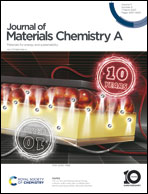(Fe, F) co-doped nickel oxyhydroxide for highly efficient oxygen evolution reaction†
Abstract
In the study of earth-abundant oxygen evolution reaction (OER) electrocatalysts, cation-doping is an extensively used strategy to boost the catalytic performance, whereas anion-doping is a promising yet premature approach that may potentially provide increased degrees of freedom to engineer the surface properties of OER catalysts. Herein, we report an experimental work demonstrating the pronounced effect of anion–cation co-doping in the oxyhydroxide phase on the OER performance. Our study found that anodic electrooxidation of Ni foam (NF)-supported NiO nanosheets in an electrolyte containing Fe2+ and F− resulted in the formation of an (Fe, F) co-doped NiOOH amorphous surface layer. A combination of Raman spectroscopy, XPS and XAFS analyses had provided solid evidences supporting the substitutional doping of Fe3+ and F− for Ni3+ and OH−, respectively, in NiOOH. Benefiting from the improved intrinsic activity and hierarchical nanostructure, the Ni1−xFexO(OH)1−yFy/NiO/NF catalyst exhibited excellent catalytic performance for the alkaline OER. It required an overpotential of 186 mV to afford 10 mA cm−2 and showed a potential fluctuation of only ± 15 mV over 100 h constant-current measurement at 500 mA cm−2 in a F-containing electrolyte. The outstanding performance of this noble-metal-free OER catalyst makes it promising for water-splitting application.



 Please wait while we load your content...
Please wait while we load your content...